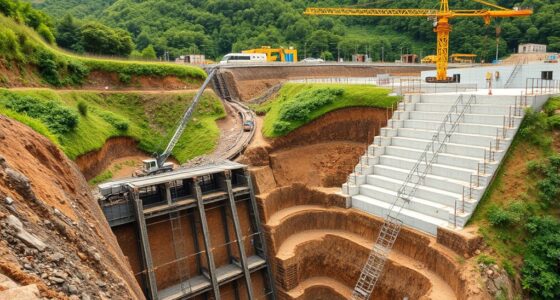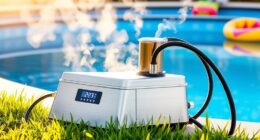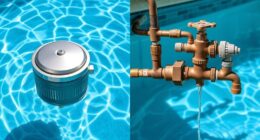Wind affects your infinity pool by disrupting water circulation, speeding up evaporation, and causing temperature drops. It can blow debris into the water, increase splash and structural stress, and challenge chemical balance and filtration efficiency. Strong gusts may threaten safety barriers and pool stability. To keep your pool running smoothly, you’ll need to contemplate wind-resistant design features and regular maintenance. Keep exploring to discover effective ways to minimize wind’s impact on your infinity pool.
Key Takeaways
- Wind-induced water movement can cause turbulence, affecting the seamless visual effect of an infinity edge.
- Increased evaporation from wind raises water levels, requiring more frequent refilling and chemical adjustments.
- Wind-blown debris can clog filtration systems and dirty the water, demanding enhanced maintenance.
- Surface ripples and waves caused by wind can diminish the aesthetic clarity of the infinity edge.
- Strong gusts may impact structural stability or cause splashing, necessitating protective barriers or covers.
The Impact of Wind on Water Circulation and Filtration
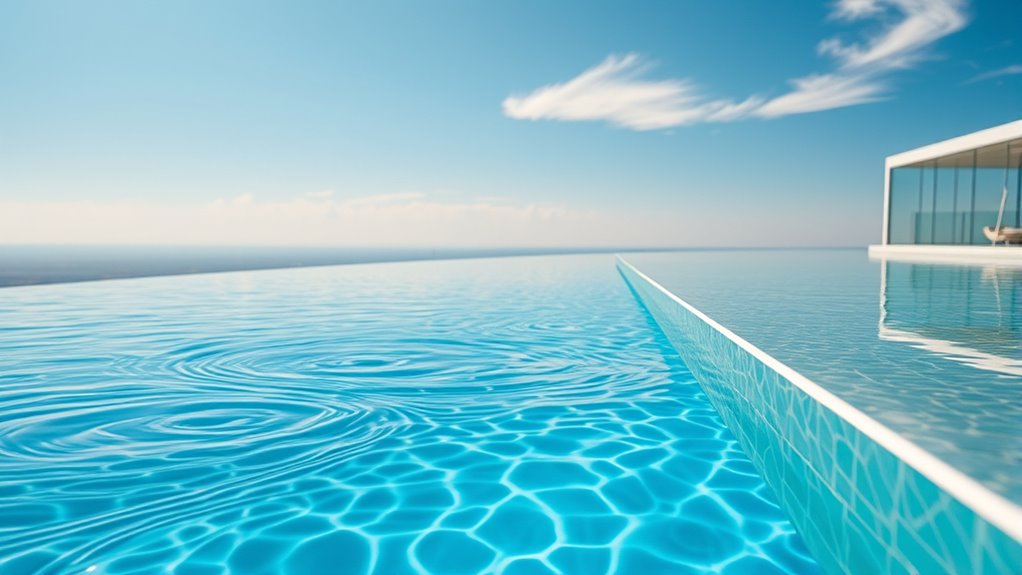
Wind plays a crucial role in how water circulates and filters in an infinity pool. When wind blows across the surface, it creates ripples and currents that help move water continuously. This natural agitation prevents stagnation, ensuring debris and contaminants don’t settle at the bottom. The movement also promotes even distribution of chemicals, like chlorine, which keeps the water sanitized. Additionally, wind-driven currents improve the efficiency of filtration systems by encouraging water to flow more uniformly through filters. Without this movement, your pool could develop dead zones where water quality deteriorates. Proper water circulation is essential for maintaining a healthy pool environment. So, as wind interacts with your infinity pool, it actively supports proper circulation and filtration, helping maintain clear, healthy water with less effort from mechanical systems.
How Wind Influences Evaporation and Water Levels

When the breeze picks up over your infinity pool, it accelerates the rate of water loss through evaporation. As wind blows across the surface, it removes the thin layer of moist air, making way for more water molecules to evaporate. This means your water level can drop faster on windy days, requiring more frequent refills. You might notice the water receding quicker than usual, especially during hot, breezy afternoons. To keep up with this loss, you’ll need to monitor water levels regularly and top up when necessary. Wind also increases evaporation rates, impacting water conservation efforts and pool maintenance. Incorporating smart pool technology can help monitor water levels automatically and alert you when refills are needed.
Wind increases evaporation, causing water levels to drop faster and requiring more frequent refills.
- Faster water level drops during windy days
- Increased need for refilling
- Higher evaporation rates in hot weather
- More frequent water testing and topping
- Potential for water imbalance if neglected
Safety Considerations: Wind and Pool Stability

When wind blows across your infinity pool, it can cause water to circulate unevenly and impact stability. You’ll need to contemplate structural reinforcement to withstand strong gusts and prevent damage. Installing safety barriers and enclosures helps protect everyone and keeps your pool area secure during windy conditions. Additionally, considering odour control features in pool maintenance can help mitigate unpleasant smells caused by wind-induced debris.
Wind-Induced Water Circulation
As gusts pick up, they can create noticeable water movement in an infinity pool, affecting both safety and stability. This wind-induced circulation can cause ripples, waves, or even surface turbulence that might surprise swimmers or disrupt the pool’s appearance. You may notice water splashing over edges or uneven flow patterns, which can stress the pool’s structure over time. To stay safe, keep an eye on water movement during strong winds and avoid swimming if waves are significant. It’s also wise to secure loose items around the pool area to prevent accidents. Regularly monitor water levels and flow patterns to catch any irregularities early. Additionally, understanding water circulation patterns can help you better anticipate how wind impacts your pool’s stability. Staying attentive helps ensure your pool remains safe, stable, and visually stunning even when the wind picks up.
Structural Reinforcement Needs
Because wind can exert significant lateral force on an infinity pool, ensuring proper structural reinforcement is essential for maintaining safety and stability. You need to assess the pool’s design, foundation, and surrounding materials to withstand these forces. Reinforcements like reinforced concrete, sturdy beams, and anchoring systems prevent movement or damage. To help you evaluate, consider this overview:
| Reinforcement Type | Purpose | Key Features |
|---|---|---|
| Reinforced Concrete | Structural stability | High tensile strength |
| Anchor Bolts | Securement against wind loads | Deep embedding, corrosion-resistant |
| Support Beams | Load distribution | Heavy-duty, flexible materials |
Proper reinforcement minimizes risks, ensuring your infinity pool remains safe even during strong winds. Additionally, understanding merchant services can be crucial for managing the financial aspects of your construction project efficiently.
Safety Barriers and Enclosures
Strong wind conditions can considerably compromise the stability of safety barriers and enclosures around your infinity pool. When gusts are strong, barriers might sway, loosen, or even topple, creating safety hazards. It’s crucial to regularly inspect and maintain these structures, especially before storms or high-wind periods. Consider upgrading to wind-resistant materials or adding additional support brackets. Ensure gates and latches are secure to prevent accidental openings. Installing windbreaks like screens or shrubs can also help reduce wind force. Remember, your safety barriers are your first line of defense, so keeping them sturdy and well-maintained safeguards everyone around the pool. Regularly check for loose fittings or damage, and consider the benefits of structural stability to enhance safety. Use durable, weather-resistant materials, install windbreaks or screens, reinforce with additional supports if needed, and lock gates securely during high winds.
Effects of Wind on Water Temperature and Chemical Balance
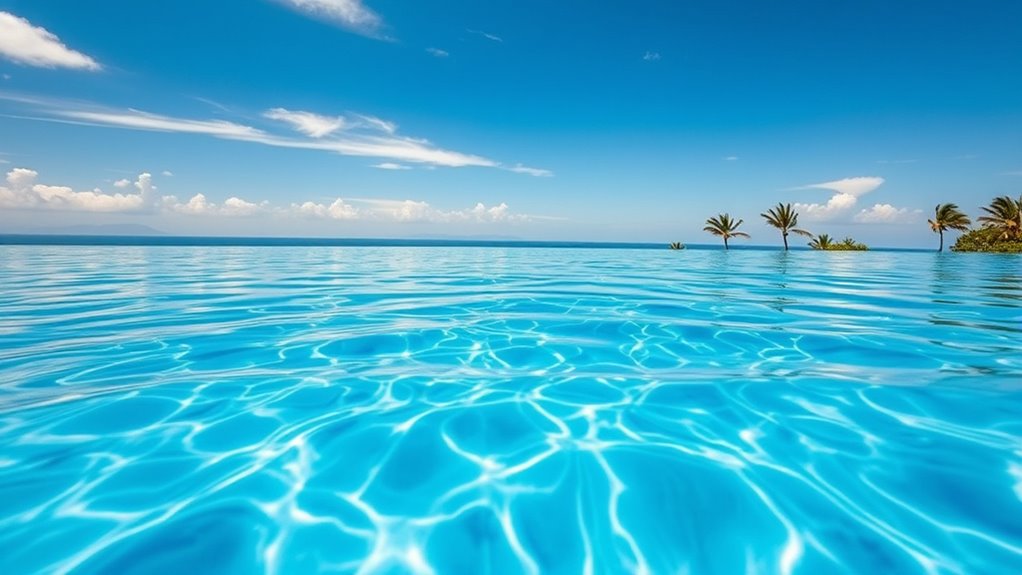
Wind can cause your pool’s water temperature to fluctuate, making it harder to keep it at a comfortable level. It also stirs up chemicals, disrupting the delicate balance you’ve worked to maintain. Understanding these effects helps you better manage your infinity pool’s operation. Additionally, regularly reviewing your chemical levels is essential to respond promptly to changes caused by wind disturbances.
Temperature Fluctuations Driven by Wind
When wind blows across an infinity pool, it can markedly influence water temperature by increasing heat loss through evaporation and convection. This often results in sudden temperature drops, especially on windy days. You might notice the water feels cooler than expected or fluctuates throughout the day. Wind accelerates evaporation, taking heat away and cooling the water faster. Additionally, it stirs the surface, promoting heat exchange with the cooler air. These fluctuations can make maintaining a consistent temperature more challenging. To manage this, you could consider installing windbreaks or using a pool cover during windy periods. Recognizing how wind-driven temperature changes happen helps you better plan pool use and maintenance, ensuring you enjoy a comfortable swimming experience despite weather shifts. Proper monitoring techniques can also help track temperature fluctuations and optimize pool conditions.
Chemical Balance Disrupted by Wind
As the weather shifts and breezes flow across your infinity pool, the movement of air can disturb the delicate chemical balance of the water. Wind increases evaporation, which can concentrate chemicals like chlorine and pH levels, throwing off the balance. It can also introduce dust, leaves, and other debris that carry contaminants, leading to uneven chemical distribution. This disruption makes it harder to maintain proper sanitation and clarity. Additionally, wind-driven splashes can cause rapid changes in water chemistry, requiring more frequent adjustments. If left unchecked, these fluctuations can promote algae growth, bacteria buildup, and corrosion of pool equipment. To keep everything in check, you’ll need to test the water more often and make timely chemical adjustments to ensure safe, balanced water. Understanding how water chemistry interacts with environmental factors like wind can help you better manage your pool’s condition.
Design Features and Strategies to Minimize Wind Effects
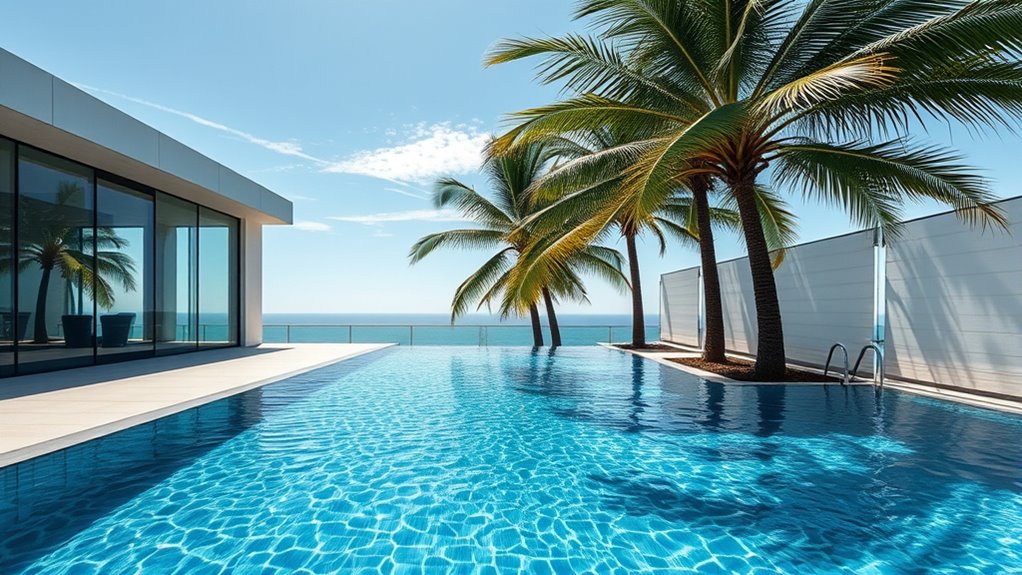
To effectively reduce the impact of wind on an infinity pool, thoughtful design features and strategic planning are essential. Incorporating windbreaks can shield the pool area, minimizing disturbances. You might consider installing tall hedges, fences, or glass panels around the pool to block gusts. Positioning the pool in a sheltered location, such as behind a building or natural barrier, also helps. Using aerodynamic pool covers or wind-resistant fencing can further reduce wind effects. Additionally, designing the pool with a slightly recessed edge can limit wind turbulence. Incorporating farmhouse-inspired landscaping such as natural wood accents or rustic plantings can enhance the aesthetic while serving as effective wind barriers. Add landscape features like trees or shrubs as natural wind barriers. Use glass or acrylic panels for clear wind protection. Position the pool away from open, exposed areas. Incorporate wind-resistant fencing or screens. Design the pool edge with a slight inward slope.
Maintenance Challenges Caused by Wind-Related Factors

Wind not only influences the design of an infinity pool but also creates several maintenance challenges. Strong gusts can blow debris, leaves, and dirt into the water, increasing filtration needs and risking clogging filters. You’ll find yourself cleaning the pool more frequently, especially after storms or windy days. Wind-driven water evaporation also leads to water level fluctuations, requiring constant monitoring and topping off. Additionally, persistent wind can cause water splashing over the edges, leading to water wastage and potential damage to surrounding structures. Wind can also accelerate wear and tear on pool equipment, such as pumps and filters, by increasing their workload. To maintain ideal operation, you’ll need to implement regular cleaning schedules, monitor water levels, and inspect equipment for wind-related damage.
Frequently Asked Questions
How Does Wind Speed Impact the Structural Integrity of an Infinity Pool?
Higher wind speeds can put extra stress on your infinity pool’s structure, especially on the edge and supporting elements. You might notice increased movement or vibrations, which could weaken the foundation over time if not properly designed. To protect your pool, make certain it’s built with sturdy materials and regular inspections. Wind-related forces can be managed with appropriate engineering, but ignoring them might lead to damage or safety hazards.
Can Wind-Induced Vibrations Affect the Pool’s Filtration System?
Yes, wind-induced vibrations can affect your infinity pool’s filtration system. When strong gusts cause the structure to vibrate, it can loosen connections or damage delicate components inside the filtration unit. This may lead to leaks, reduced filtration efficiency, or even system failure. To prevent this, make certain your pool is properly anchored and regularly inspected. Addressing vibrations early preserves your system’s performance and extends its lifespan.
What Are the Best Materials to Reduce Wind Damage in Infinity Pools?
You should choose durable materials like reinforced concrete, stainless steel, or high-quality tempered glass for your infinity pool. These materials resist wind damage better and withstand harsh weather conditions. Incorporate windbreakers such as strategic landscaping, fences, or glass panels to shield your pool area. Regular maintenance and inspections guarantee the materials remain strong over time, helping to prevent wind-related issues and prolong the pool’s longevity.
How Does Wind-Driven Debris Affect Pool Maintenance and Cleanliness?
Wind-driven debris can considerably impact your pool’s maintenance and cleanliness. You’ll find leaves, twigs, and dirt constantly blowing into the water, making it necessary to clean the surface frequently. Debris can clog filters and skimmers, reducing their efficiency. Regular skimming, vacuuming, and filter checks become essential to keep your infinity pool sparkling and safe. Staying vigilant ensures debris doesn’t accumulate and cause long-term issues.
Are There Specific Wind Conditions That Make Swimming Unsafe in an Infinity Pool?
Think of wind as an unruly guest at a fancy party—some days, it’s gentle and welcoming; other days, it’s disruptive. Strong winds, especially gusts over 25 mph, can make swimming unsafe in an infinity pool by causing sudden waves, loss of balance, or debris flying into the water. Always check weather conditions before swimming, and avoid the pool during high wind alerts to guarantee your safety.
Conclusion
As wind continues to challenge your infinity pool’s delicate balance, every gust could alter water clarity, temperature, or safety. Will your design withstand the relentless forces, or will unexpected breezes cause unforeseen issues? Stay vigilant, because the next gust might be the one that tests your pool’s resilience. Prepare now, and verify that when wind howls, your infinity pool remains a stunning, serene escape—no matter what the weather throws your way.


